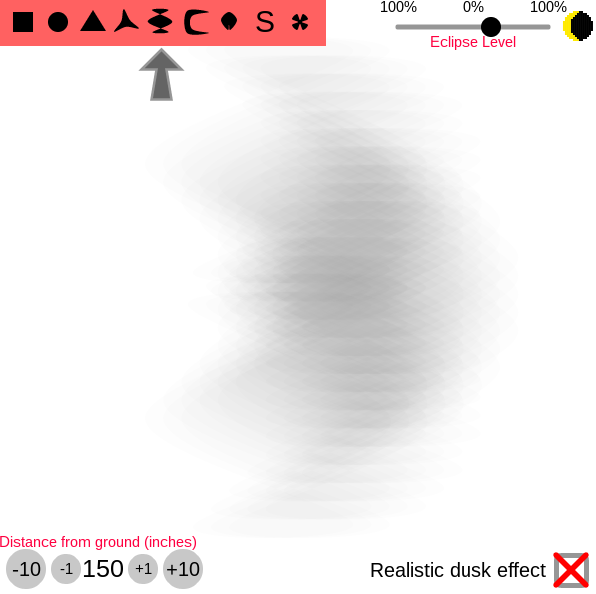[A little introduction by Marathon: ]
We were talking about solar eclipse phenomena recently. I told the kids about my memories from eclipses that I experienced as a boy, especially about how all the leaves of a tree would cast shadows that looked like the shape of the eclipse.
After the conversation, I did some image searches so I could show them what I remembered.
I was stunned to find that the truth was nothing like I remembered it!
Instead, there are thousands of images showing pinhole-camera effects. That is, the light from the sun passes through tight squeezes between the leaves and casts itself on the ground as an inversion of the sun’s distorted shape. Here is a typical example (Photo by Neal Wellons):
I couldn’t find a single picture to support what I remembered!
But I couldn’t seem to let go of it either. Without being able to explain very well why, it just seemed to me that there would be an eclipse shadow effect separate from the well-known pinhole effect.
I muttered something to the effect of, “We’d need some fancy lighting or a computer program to know if there was any truth to what I was thinking.”
Little did I know that wheels had been set in motion…
Over the past week, I have been working on a project. A coding project.
Sometimes we would play games with light during supper, when the light from the sun would reflect off glass buildings. I noticed that the shadows were almost perfectly crisp, even though our shadows fell on a wall that was 15-20 feet away.
That isn’t the case when the light is coming straight from the sun.
In the morning’s direct sunlight, the shadows are all fuzzy, and they would do all kinds of crazy stuff, like jumping over to other shadows, or some shadow that is a lot thinner than it should be…
A week ago, I had a realization about why shadows seem to warp sometimes.
I had always assumed that it was from the light of the sun bending, slightly.
But that isn’t the case. I realized that if you have a small slit letting sunlight through, there will be a light spot on the ground that is a good bit wider than the small slit. I realized this was because of the light from the right side of the sun shining through to the left of the slit, and vice versa.
During an eclipse, also, a tree shows many mini eclipses on the ground, on it’s shadow. This, we found out, is due to the pinhole effect.
Marathon still felt that a normal object, without a pinhole might also give an eclipse-like shadow. We made this big sketch, we kept messing up, but finally, we were pretty sure that any object would give a slightly eclipse-like shape.
It would take a long time to explain it all in writing. It’s pretty complicated.
So, instead, I did this coding project to make it easier to understand:
https://www.khanacademy.org/computer-programming/eclipses-shadow/5898189205209088
I consider ~150 inches from the ground to be the best distance for seeing the eclipse-like shadow.
Hope you like it!
[Marathon: So, thanks to Doodle’s javascript program, we can see how a shadow of basically anything leaf-sized, that is positioned around 12 feet above the ground, gets distorted by parallax effects to look vaguely like the crescent of the eclipse.
Here’s a leaf-like shape’s shadow at 10 inches above the ground during an ~80% solar eclipse:
Now here’s the same shape’s shadow at the same moment if it was 12 feet off the ground:
Totally different!
Even the staple shape, that already is a crescent of sorts, will bend to roughly become a crescent in the opposite direction! Try it for yourself.
Here’s another neat effect we found. If you set the moon’s size to be slightly smaller than the sun so that it allows for a “ring of fire” at the point of complete eclipse, here’s what the shadow of a ping-pong sized ball looks like.
Another symmetrical shape that gets bent into a crescent:
And finally, I was able to find a photo that shows this effect. The key is to find and eclipse shadow photo of just a few leaves so that the pinhole effect doesn’t dominate. Thanks to Flickr contributor Paul Sableman. Notice how all the leaves have a distinct concavity facing right.







Leave a Reply